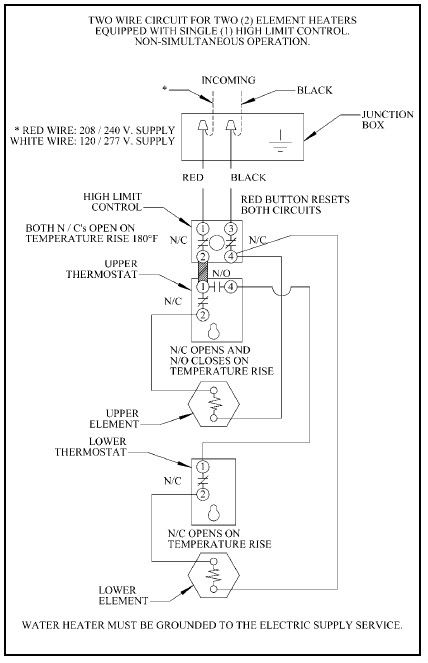partimer31
Member
Pushmatiic circuit breaker panel. Very old, with rust stains.
Panel does not have a split bus design.
I call the left vertical power bus, Phase A.
I call the right vertical power bus, Phase B.
Bolted to Phase A, is a single pushmatic 30 A. circuit breaker
Bolted to Phase B, is a single pushmatic 20 A. circuit breaker
Together, They make one single 240 volt circut.
240 volt load is a electric storage hot water tank. This tank has both
an upper and lower heating elements. I check then both. And they
tested okay at the time, the upper would come up temperature, then the
control would switch over one leg of the 240 volt circuit down to the
lower element thermostat control, which passes the 120 volt to the lower
element. The other leg of this 240 volt circuit, Phase B, is parallel
wired to both upper and lower element.
The other leg of this 240 volt circuit is connected to both upper and
lower elements, (phase B), by being wired in parallel. (there are not
controls or thermostat wire into this circuit)
The electric hot water tank works most of the time, but lately the 30 A.
breaker has been tripping, it least once a day,
I am puzzle, why the 30 A. breaker and not the 20 A. breaker.
I thinking about replacing all upper and lower thermostats, plus the upper
control on the hot water. Or should I just buy a new P230 pushmatic
30 A. breaker, this would eliminate the two individual breakers, making up
the 240 volt circuit to the electric hot water tank.
Any suggestion, other them complete replacement of the pushmatic circuit
breaker electrical panel.
Panel does not have a split bus design.
I call the left vertical power bus, Phase A.
I call the right vertical power bus, Phase B.
Bolted to Phase A, is a single pushmatic 30 A. circuit breaker
Bolted to Phase B, is a single pushmatic 20 A. circuit breaker
Together, They make one single 240 volt circut.
240 volt load is a electric storage hot water tank. This tank has both
an upper and lower heating elements. I check then both. And they
tested okay at the time, the upper would come up temperature, then the
control would switch over one leg of the 240 volt circuit down to the
lower element thermostat control, which passes the 120 volt to the lower
element. The other leg of this 240 volt circuit, Phase B, is parallel
wired to both upper and lower element.
The other leg of this 240 volt circuit is connected to both upper and
lower elements, (phase B), by being wired in parallel. (there are not
controls or thermostat wire into this circuit)
The electric hot water tank works most of the time, but lately the 30 A.
breaker has been tripping, it least once a day,
I am puzzle, why the 30 A. breaker and not the 20 A. breaker.
I thinking about replacing all upper and lower thermostats, plus the upper
control on the hot water. Or should I just buy a new P230 pushmatic
30 A. breaker, this would eliminate the two individual breakers, making up
the 240 volt circuit to the electric hot water tank.
Any suggestion, other them complete replacement of the pushmatic circuit
breaker electrical panel.
Last edited:


